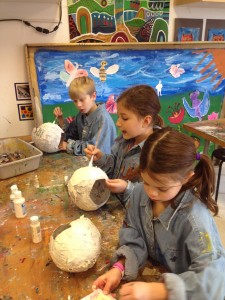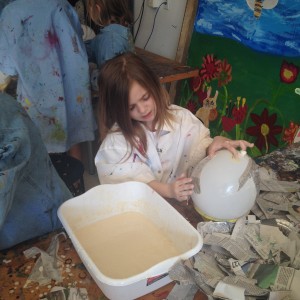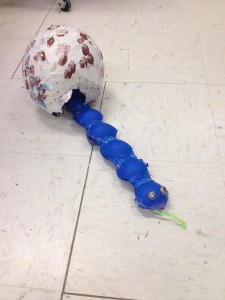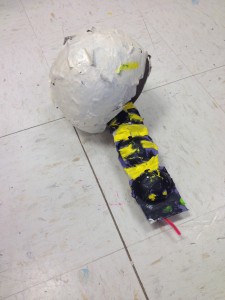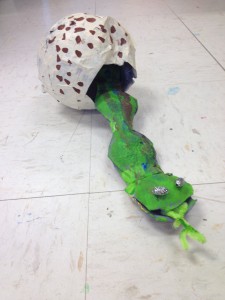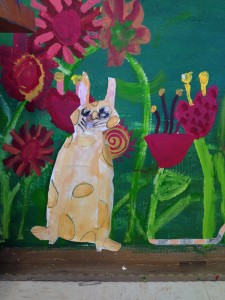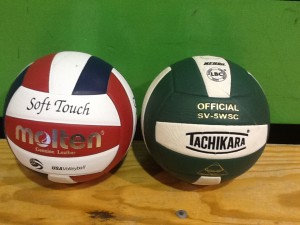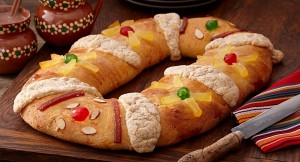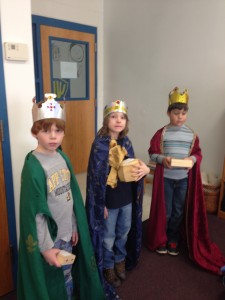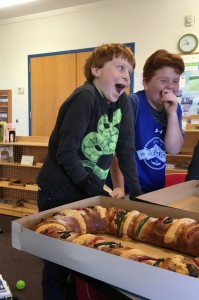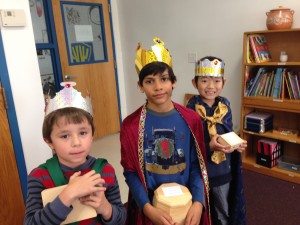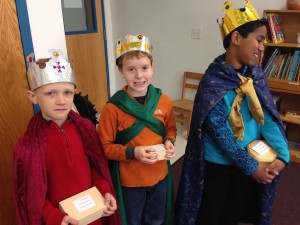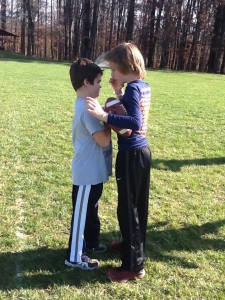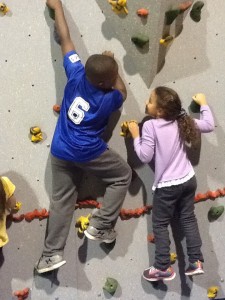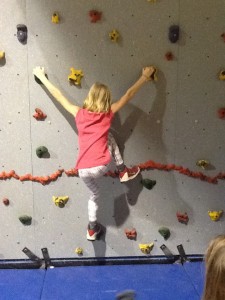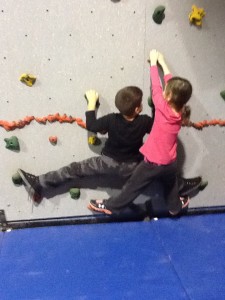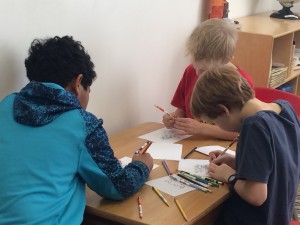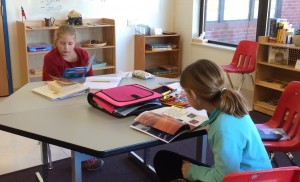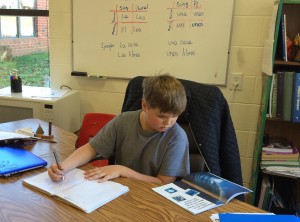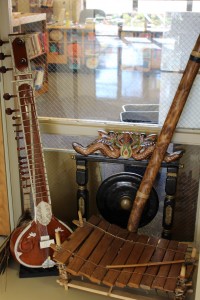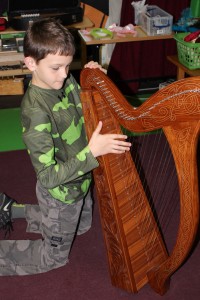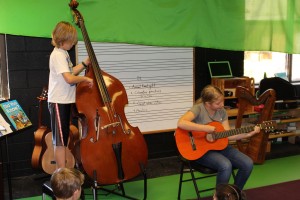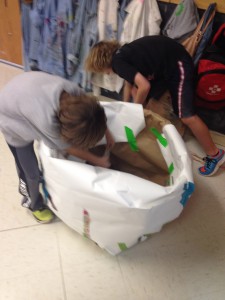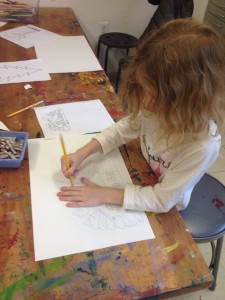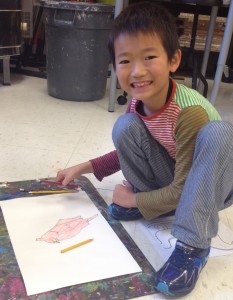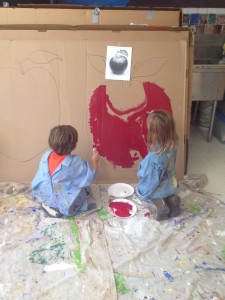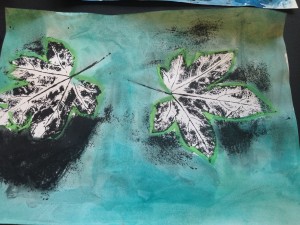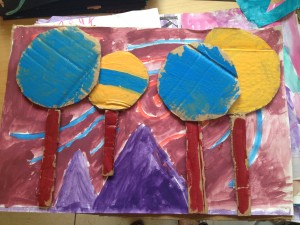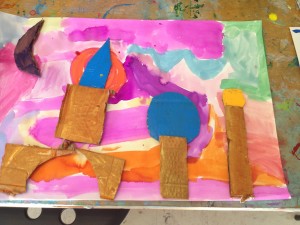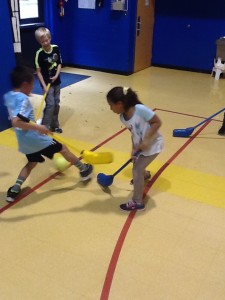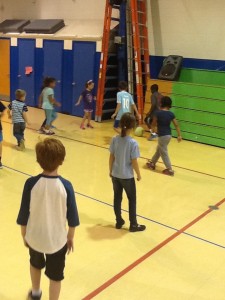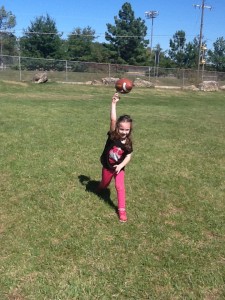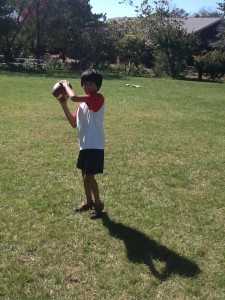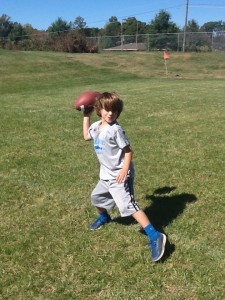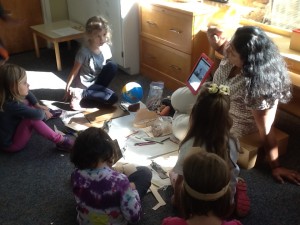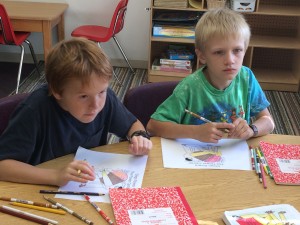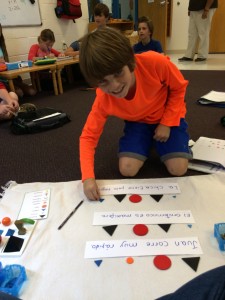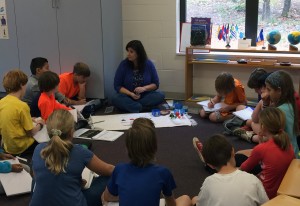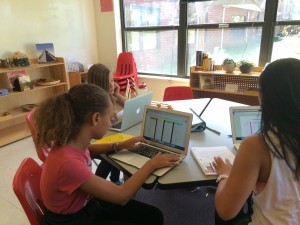Look what has hatched in the art room!
Lower elementary art students have been learning about life cycles in their classrooms and this prompted our current art project. Large eggs were created out of paper mache. Students learned an inexpensive and natural way to make paper mache. They may want to create this recipe at home. It is a simple recipe of equal parts of flour and water. I usually start with 1 cup flour and 1 cup water. Mix to get a paste like consistency and add water if too thick and flour if too watery. The students enjoyed mixing the recipe and getting it just right. So fun and so messy! Take a look at the process.
The following week they created either a snake or a caterpillar hatching out of their egg. This has been a great lesson for students to practice patience while working on a 3 dimensional art project that took many weeks. They are excited about completing their final art piece. Be on the look out for these marvelous creatures!
Students have also worked on scenery for their upcoming program about life cycles. Here is a sneak peek of one of their pieces.
Volleyball begins right after our winter holiday break for students in the Elementary and Middle School. The classes focus on teamwork and communication in volleyball. Lower El is working hard on basic serves and hits. Upper El is playing without the need of a training ball (they are using one of the 2 pictured below) and middle school is midway through their ISL competitive volleyball season. Go Panthers! Championship game is Thursday, February 11.
Volleyball is a great team sport and makes the kids rely on their fellow team players in a way that other sports don't. It is rarely the case that a player can just hit the ball hard and score a point. In volleyball players must be able to hit the ball with some accuracy or at least be able to bump the ball straight up to set it for the player who can hit it over the net. Communication is essential to success! Sometimes it is challenging enough for youngsters to just get a good hit on the ball. But the other big challenge is to have enough confidence in your teammates that they will assist in the volley in order to get the ball over the net. In the end, whoever wins or loses doesn't matter, because the main lessons are about teamwork and good communication.
Following our unit on volleyball, we will move directly into basketball season. March Madness... here we come!!!
Thanks, Terry
Educating the Whole Child Research confirms that students perform better in school when they are emotionally and physically healthy. They miss fewer classes, are less likely to engage in risky or antisocial behavior, concentrate more and attain higher test scores.
January was a busy month in our Spanish classes, but we also had time to learn about Día de Reyes (Three Kings Day), a Spanish tradition celebrated on January 6 (the 12th day of Christmas) that commemorates the story of the three wise men who traveled from afar bearing gifts for the newborn Jesus. Hispanic children often set out symbolic goodies for the Kings and hay to feed their camels as well as a place to leave their shoes. When morning arrives, children discover that the camels ate the hay, and there are wrapped presents waiting beside their shoes.
Did de Reyes observance comes to a close with another Spanish Christmas tradition: a typical breakfast of Roscón de Reyes, a ring-shaped cake decorated with fruits symbolizing the precious gems that adorned Los Reyes Magos' clothing.
Our kids observed this tradition by sampling the Roscón de Reyes.
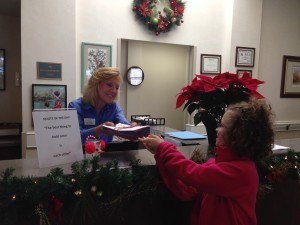
Willa delivering the Holiday cards to Well Spring Retirement Community made by Lower El students
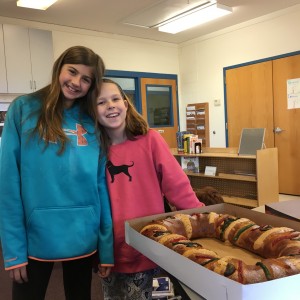
Bella and Lola ready for the Rosca
Greensboro Montessori School Elementary Spanish lessons practice vocabulary for shopping "en el mercado."
This Holiday Edition of the Physical Education blog is all about keeping kids active to build stronger bodies and stronger minds. First and foremost, it is important for parents to set an example by being active and making fitness a priority in your home.
In PE class at this time of year, we try to do a variety of activities inside and outside so that we can keep the students engaged and moving. While we are outside we enjoy soccer and flag football, and while we are inside the students love to scale the climbing wall in pairs. Check out our photos below from this month's activities.
Keeping the children active during the holiday season is especially important due to the overeating that is typical at this time of year.
Its no secret that physical activity also improves brain functioning. As you can see from the sample brain scans below, a mind on exercise is an active mind! Look at the brain functioning after just 20 minutes of walking. Getting kids to move helps strengthen and stimulate their brains. This is why so many recent research studies are showing increased fitness = improved academics. Note: The blue color represents inactivity in the brain.

Here are a few tips that might be some help during the holidays to keep your kids active.
The following are tips from www.raisesmartkid.com in an article entitled The Benefits of Exercise on Your Kid's Brain.
- Set example to kids by being active yourself. Engage in a lot of walking, running, biking or playing sports. A study suggests that preschool kids whose moms are active also tend to be active themselves. According to Esther van Sluijs from the University of Cambridge School of Clinical Medicine who made the study, parents affect their kids in three ways – by acting as role models, by helping them to be active, and by being active with them.
- Make fitness a priority in your home. Set limits on watching TV, playing video games, and being in the internet.
- Make fitness fun. Engage your kids in fun sports or other games which he loves. Also, don’t limit your kid to playing traditional sports. There are video games like Dance Dance Revolutin that can be played actively.
- Encourage your kid to walk. Don’t use the car if you and your kid are going to places where you can walk to. Look for opportunities to walk, find places to stride like a mall, and stairs to climb. Build you kid’s walking muscles so that distances that used to be far for him will feel near. Make your child get used to and love walking. This will benefit him throughout his life.
- Encourage your kid to run. Teach him the joys of jogging. Run with your kid, or make it a social activity, with friends or relatives.
- Encourage your kid to use wheels. Not wheels of a car, but bikes, scooters, rollerblades or skateboards (make sure they have adequate protection like helmet, elbow pads, long pants). On his next birthday, give him one of these gifts instead of another video game.
- Encourage your kid to dance. Dancing is one thing some kids enjoy more than conventional exercise.
- Encourage some competition. If your kids have other family members or friends, make them compete with each other in a fun way. For example, there’s always the running race (give the younger kid a distance advantage), but you can think of other creative contests like who can do the most jumping jacks, skipping rope, etc.
- Go to regular outings. Take a hike. Explore a nearby park. Enjoy the outdoors. Remember to bring a ball or a frisbee.
- Don’t be too strict about an active life. Although a regular routine of being active is what’s best, perfection is not your goal. When your kid has a busy day, try to get him to do his best to be active, but if this is not possible, schedule longer activity days when he has more time.
- Parents of teens should be cautioned against having their kids play contact sports like football. According to Dr. Robert Cantu, chairman of the Department of Surgery at Emerson Hospital and co-director of the Center for the Study of Traumatic Encephalopathy at the Boston University School of Medicine, kids under the age of 14 should not be involved in collision sports. Teenagers who played contact sports often already show signs of chronic traumatic encephalopathy, or CTE, a degenerative brain disease caused by multiple blows to the head. The symptoms are personality changes, memory loss, depression, even dementia.
In Spanish classes, the highlight of this month was the end of the year holidays. The students learned about celebrations around the world and their influence on Latin-America.
Primary
by Yeny Hernandez [dt_sc_email emailid="[email protected]"/]
The excitement of the end of the year celebrations was present in the Primary classes. In Spanish, we discussed the different celebrations around the world which have the common theme of light. Apart from talking, drawing and singing, the kids worked with lights related vocabulary like Luz (light), estrella (star), luna (moon), and sol (sun).
Lower Elementary
by Susana D'Ruiz [dt_sc_email emailid="[email protected]"/]
In our lessons on the end of year holidays, we covered Fiestas Alrededor del Mundo (Festivities Around the World) most of which use lights symbolically in their celebrations. One of the activies we did to commemorate the holidays was to make different celebration cards to be delivered to Well Spring Residence. The students wrote them in Spanish and English.
Upper Elementary
by Susana D'Ruiz and Sandra O. Lee
Fourth Level
This month, the 4th level students have been busy working on parts of speech, vocabulary and phonetics. Our goal is to start working on sentence analysis in Spanish as soon as we return from Winter Break.
Fifth Level
The main contents in 5th level were Geography in Spanish, where the students learned about Central and South American countries, their capitals and borders, and reading comprehension and the use of the dictionary. The kids read "Nuestra Tierra" (Our Earth), and had to write questions and definitions related to the book.
Middle School
by Sandra O. Lee [dt_sc_email emailid="[email protected]"/]
This is a busy time of year for middle schoolers with several projects coming to fruition. Along with this, we maintained our daily focus on Spanish language and academics. The students continued working on the Realidades Program, and their customized review packages. They also had the opportunity to talk about and review the world lights celebrations and listen to Villancicos (traditional Christmas songs in Spanish).
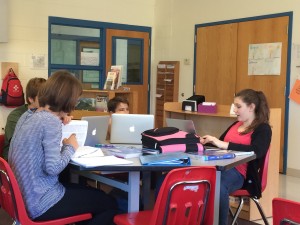
At the Greensboro Montessori School we have a world cultural music curriculum in the Primary through Upper Elementary classes. Students watch, listen, and read about a culture’s music and and then work to present a world music concert where they perform cultural songs, dances, story-dramas and play instruments from specific cultures.
We are lucky to have a beautiful collection of functional world music instruments for the students to see and perform on, some of which are displayed in our school’s library showcase.The upcoming elementary winter world music concerts will feature instruments from Europe, such as the accordion, Irish bodhran, penny whistle, the celtic harp, xylophones and guitars. In preparation for the concert, Lower and Upper Elementary students have been delightedly bringing stories to life from Scotland and Wales called, “The Bonnie Banks of Loch Lithy” and “Morgan’s Spell.”
Toddler and Primary music classes have been enjoying animal songs, playing hand percussion and singing songs about rain, vertebrates, kookaburras and singing in French. Favorite songs in toddler music classes have been, “Horsey, horsey” and “See the pony galloping”. In primary music classes there has been robust singing by students on the refrain of “Puff the Magic Dragon” as we follow the illustrated story-song and lots of expressive movement to the song, “Rhythms all Around.”
Art and music classes have been working together to prepare for the upcoming winter concerts on December 3 and 10.
Upper and Lower Elementary students have been using their art time to create stage props for the concerts. Huge boxes have been transformed into many interesting things. A favorite of the boys has been a large cauldron made from chicken wire, newspaper and lots of tape. We made homemade paper mache' and had a messy good time creating the cauldron.
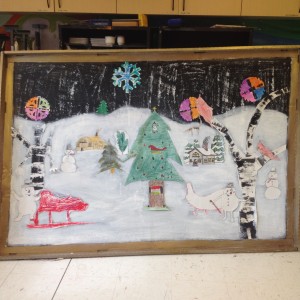
A collective display of winter.Lower elementary students have been creating winter scenes to add to this large piece of art that will be displayed at the winter concerts.
Lower elementary students have been creating winter scenes to add to this large piece of art that will be displayed at the winter concerts.
Other happenings in the Montessori art room include printmaking with leaves. Lower elementary students used leaves to create beautiful prints. They also painted the negative space with watercolors. In combination with their study of European culture and music, Lower El students were also introduced to the work of artist and architect, Friedensreich Hundertwasser. He was from Austria and his artwork had a childlike, playful style. Take a look at the students' work that was inspired by Hundertwasser.
I look forward to seeing you at the winter concerts where you will see all of this fabulous artwork created by our talented Montessori art and music students.
Be inspired!
Katherine Gwynn
Elementary and Middle School students at Greensboro Montessori School work and play hard in their physical education classes. Lower Elementary works out 1 day a week for 55 minutes, Upper Elementary works out 2 days a week for 50 minutes and Middle School works out twice a week for 55 minutes. Early in the school year, each class starts off with a fitness evaluation. In this evaluation, we test each student's 1) resting heart rate, 2) muscle strength with push-ups and sit-ups, 3) cardiovascular levels with 1/2 mile or 1 mile walk/jog and 4) flexibility with the sit-n-reach test. The first test is a benchmark for the year; then each student will do a retest before Winter Break and again before summer break.
So far this fall we have completed units on soccer and football. In soccer, students, practiced all the foot skills associated with that sport. Soccer is still the favorite sport of every class - Lower Elementary, Upper Elementary and Middle School. We then moved into a unit about American football. To keep all the students interested, we changed it up and converted the game of ultimate frisbee to ultimate football. Students got plenty of practice with eye hand coordination skills, team work skills and had a fast moving game to play at the same time. This unit worked in conjunction with the Middle School after school sports program All of the age groups are getting to develop their skills towards the big goal of playing on the middle school flag football team.
Occasionally we take a break from the schedule and work on our teamwork skills with a good ol'game of floor hockey or kickball.
This month, in which Latin America remembers the “Encounter of Two Worlds”, the students were busy in the classrooms learning, working, researching and presenting their work about our rich Hispanic culture and its people. Below is a glimpse of our activities.
Primary
by Yeny Hernandez [dt_sc_email emailid="[email protected]"/]
This has been an active month in Primary in Spanish. The students worked with geometry, recognizing the different geometrical shapes and naming them as they created figures with them.
We also celebrated the Hispanic Heritage Month, talking about different aspects of it: history, geography and art among others.
We look forward to another month of exciting activities!
Lower Elementary
by Susana D'Ruiz [dt_sc_email emailid="[email protected]"/]
In cultural studies, we covered Mes de la Herencia Hispana (National Hispanic Month), songs and cultural content. As an end to cultural month, we read about one of the most renowned Mexican artists, Diego Rivera. In phonetics, the emphasis was on /m/ sound and syllable formation for first level students, and /d/ sounds and syllable formation for second and third levels.
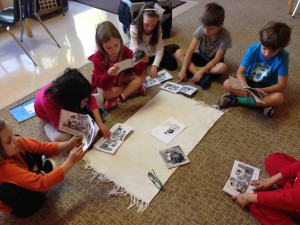
Students working on their phonetics books
Upper Elementary
by Susana D'Ruiz and Sandra O. Lee
Fourth Level
The fourth level students have transitioned well into Upper El. This past week the lessons focused on noun gender. In vocabulary the emphasis was on useful phrases for the Spanish class.
Fifth Level
This month the students have been busy working on vocabulary and sentence analysis. They compared the Spanish versus the English patterns using the Montessori Grammar Symbols. They continue working on vocabulary and phonetics.
Middle School
by Sandra O. Lee [dt_sc_email emailid="[email protected]"/]
Part of October has been marked for the visit of our friends from our sister school in Costa Rica. Our kids had the opportunity to make new friends, practice Spanish and get ready for their trip to Costa Rica in May. But we do not forget about academics during "Mes de la Hispanidad" in which we celebrate the "Encounter of Two Worlds". The students in Middle School researched and presented their work about different people, natural wonders and monuments from Spain and Latin America.
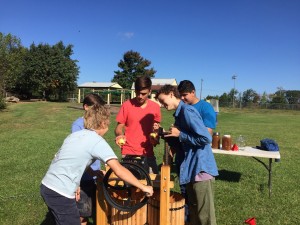
Middle schoolers working with some of our new friends who visited from Costa Rica.

